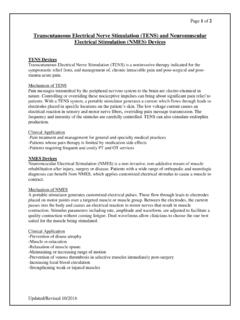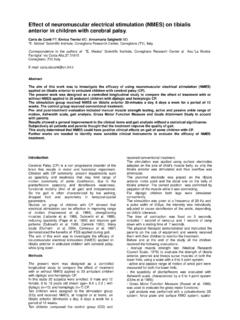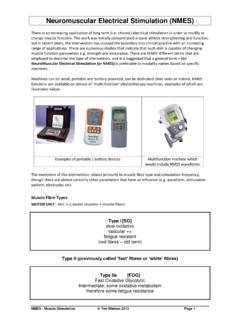Transcription of The Effect of Neuromuscular Electrical Stimulation …
1 *Address correspondence to Michael M. Reinold, Rehabilitation Coordinator/Assistant Athletic Trainer, Boston Red Sox Baseball Club, Coordinator ofRehabilitation Research & Education, Massachusetts General Hospital Sports Medicine Service, Fenway Park, 4 Yawkey Way, Boston, MA 02215 (e-mail: or more of the authors has declared a potential conflict of interest: Kevin E. Wilk and Michael M. Reinold received a fee for organizing an educationalprogram with EMPI which is the device used in this American Journal of Sports Medicine, Vol.)
2 X, No. XDOI: 2008 American Orthopaedic Society for Sports MedicineThe Effect of Neuromuscular ElectricalStimulation of the Infraspinatus on ShoulderExternal Rotation Force Production AfterRotator Cuff Repair SurgeryMichael M. Reinold,* PT, DPT, ATC, CSCS, Leonard C. Macrina, MSPT, CSCS, Kevin , #PT, DPT, Jeffrey R. Dugas,#** MD, E. Lyle Cain,#** MD, and James R. Andrews,#** MDFrom the Department of Rehabilitative Research, Massachusetts General Hospital SportsMedicine Service, Boston Red Sox Baseball Club, Boston, Massachusetts; Champion SportsMedicine, #American Sports Medicine Institute, and **Andrews Sports Medicine andOrthopaedic Center, Birmingham, AlabamaBackground: Muscle weakness, particularly of shoulder external rotation, is common after rotator cuff repair Electrical Stimulation has been shown to be an effective adjunct in the enhancement of muscle :Shoulder external rotation peak force can be enhanced by Neuromuscular Electrical Stimulation after rotator cuffrepair Design:Controlled laboratory.
3 Thirty-nine patients (20 men, 19 women) who had undergone rotator cuff repair surgery were tested a mean of after surgery. Testing consisted of placing patients supine with the shoulder in 45 of abduction, neutral rotation, and 15 of horizontal adduction. Neuromuscular Electrical Stimulation was applied to the infraspinatus muscle belly and inferior to thespine of the scapula. Placement was confirmed by palpating the muscle during a resisted isometric contraction of the externalrotators. Patients performed 3 isometric shoulder external rotation contractions with and without Neuromuscular Electrical stim-ulation, each with a 5-second hold against a handheld dynamometer.
4 Neuromuscular Electrical Stimulation was applied at max-imal intensity within comfort at 50 pulses per second, symmetrical waveform, and a 1-second ramp time. The 3 trials under eachcondition were recorded, and an average was taken. The order of testing was randomized for each patient tested. A paired sam-ples ttest was used to determine significant differences between conditions (P <.05). Each group was also divided based onage, rotator cuff tear size, number of days postoperative, and Neuromuscular Electrical Stimulation intensity. Analysis of variancemodels were used to determine the influence of these variables on external rotation force production (P <.)
5 05).Results:Peak force production was significantly greater (P<.001) when tested with Neuromuscular Electrical Stimulation ( kg)as opposed to without Neuromuscular Electrical Stimulation ( kg) for all groups tested. There was no significant difference basedon the size of the tear, age of the patient, number of days after surgery, or level of Neuromuscular Electrical Stimulation :Peak shoulder external rotation force was significantly increased by 22% when tested with Neuromuscular electri-cal Stimulation after rotator cuff repair surgery. Neuromuscular Electrical Stimulation significantly increased force productionregardless of the age of the patient, size of the tear, intensity of the current, or the number of days Relevance: Neuromuscular Electrical Stimulation may be used concomitantly with exercises to enhance the amount offorce production and potentially minimize the inhibition of the rotator cuff after repair :shoulder; glenohumeral; rehabilitation; exercise.
6 Rotator cuff1 AJSM PreView, published on August 29, 2008 as Copyright 2008 by the American Orthopaedic Society for Sports et alThe American Journal of Sports MedicineRotator cuff repair surgery is a commonly performed sur-gical operation in patients who have functional limitationdue to tendon injuries. Surgical techniques have evolvedthat are less invasive, and therefore less disruptive, to thesurrounding glenohumeral soft tissue and , the patient is able to progress postoperatively withless discomfort and functional limitations from pain andmuscle inhibition.
7 The ultimate postoperative goals for therehabilitation specialist, in addition to protecting theintegrity of the repair, are to diminish pain and improvestrength and range of motion (ROM). Achieving these goalswill aid in regaining function of the limb and a return topremorbid activities of daily living. Frequently, loss offunction is related to muscle weakness, inhibition, andimbalance in rotator cuff strength, particularly of theexternal rotators, after these stud-ies have shown a loss of external rotation strength that ispersistent up to 1 year after the surgery.
8 This rotator cuffinefficiency may result in a loss of dynamic stability of theglenohumeral joint and a delay in the ability to elevate thearm without a compensatory shrug. 12,23 Consequently,the emphasis of the postoperative rehabilitation is toregain strength, minimize muscular inhibition, and initi-ate voluntary control of the rotator cuff to maintain a cen-tered humeral head within the glenoid during upper bodymovement Electrical Stimulation (NMES) has beenrecommended as an adjunct treatment for neuromuscularreeducation and strengthening due to the muscle inhibi-tion resulting from postoperative pain and joint effusion.
9 Numerous studies have shown that NMES enhances force(torque) production, muscle recruitment, and ultimatelyresults in improved gait and a quicker recovery of ,9,16,17,18 This has been demonstrated in previous stud-ies when compared with volitional exercise without NMES after anterior cruciate ligament (ACL) reconstruction andtotal knee arthroplasty (TKA).8,11,20 Although NMES maybe more effective in increasing isometric strength of themuscle, a carryover Effect may enhance the other types ofmuscle contractions (concentric, eccentric)
10 , which may leadto improved functional gains for the use of NMES for the shoulder has received littleattention in orthopaedic communities, with research lim-ited to the rehabilitation of patients after cerebral vascu-lar ,7 Although the effects of NMES have beendocumented after surgical procedures of the knee, thereis little evidence of efficacy for the use of NMES of therotator cuff after shoulder surgery. Therefore, the objec-tive of this study was to compare the peak force producedby the infraspinatus during an isometric shoulder con-traction with and without the use of NMES after rotatorcuff repair surgery.











